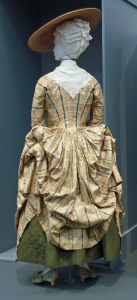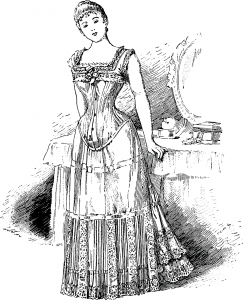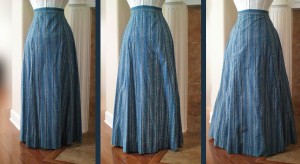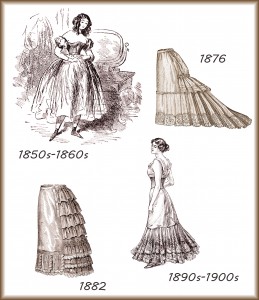Women have worn petticoats for centuries. We still do, in a manner of speaking. They’re no longer made of cotton (usually) but our modern half-slips are the equivalent of the historic petticoat.
Until the 19th century, a petticoat was simply any skirt worn separate from the dress. At first, petticoats were meant to be seen and thus had a great deal of decoration. Some were quilted or heavily embroidered, while others had edgings of lace. During the Georgian period, petticoats were often made of colored fabric and worn as a skirt beneath an overdress that was polonaised or bustled (pulled up at strategic points to create puffing).
In the early Victorian period, decorated petticoats could be worn beneath an open overdress while receiving visitors at home. A few decades later, the petticoat became primarily an undergarment, meant to be seen only as a flash of lace and ruffles at the ankle.
What is the function of a petticoat? When worn as an undergarment, it provides modesty, keeping a woman’s skirts from clinging to her legs. It adds fullness to a skirt, which in some periods was absolutely essential. Layers of petticoats add warmth in cold weather. And, as stated before, petticoats could be decorative.
Why Wear a Petticoat?
Some historic reenactors don’t bother with petticoats, decrying them as bulky, heavy, hot, inconvenient, and unnecessary. The problem is, historic garments simply don’t look right without multiple petticoats. Etiquette books suggested anywhere from two to six petticoats, depending on the decade and the in-fashion silhouette. Skirts were narrow during the Regency period, the so-called Natural Form period, and the late Edwardian period, so a woman might get away with just one petticoat. But during most of eras, Victorian or otherwise, at least two petticoats are recommended.
In hot weather, several layers of cotton or linen can actually help keep you cool. It may seem absurd, but many can attest to this fact, myself included. With long layers, you’re not exposed to direct sunlight. Also, natural fabrics tend to wick perspiration away from the body, helping you feel more comfortable. If your undergarments are made of synthetic fabrics, they won’t breathe and you’ll end up feeling hot and sticky.
As far as appearance, see for yourself the difference a petticoat can make. In the photo below, you can see the exact same skirt worn with no petticoat beneath it, with just one petticoat, and with two petticoats. The difference is remarkable, isn’t it?
A Petticoat of Your Own
You can often find late Victorian petticoats on eBay, sometimes being touted as black or white skirts. Prices vary, but you can expect that the older it is and the more decorated it is, the more expensive it will be. How can you tell the age of a petticoat? It can be difficult unless the garment comes with a documented history. You can determine the general time period by looking at the shape of the petticoat and the type of decoration.
- 1860s—Very full, yet plain, with perhaps a ruffle at the hem or a few rows of tucks.
- Early to Mid 1870s—Cut longer and fuller in the back to accommodate a bustle. Often decorated at the bottom with rows of tiny pintucks separated by bands of lace and/or embroidery.
- Late 1870s & Early 1880s—Narrower, without room for a bustle.
- Mid 1880s—Fuller and longer in back for a large bustle.
- 1890s—May be slightly longer in back to accommodate a very small bustle or “dress improver.”
- 1900s—Flared at the bottom, with vertical or diagonal bands of lace insertion. The lace might form shapes, such as zig-zags or bows.
If you plan on wearing your antique petticoat, make sure it’s strong enough and fits you well. Don’t subject it to any strain or stress. Remember that a petticoat should be about two inches shorter than your skirt and should not touch the ground, unless it’s trained.
Antique petticoats can be washed by hand with a mild detergent and hung to dry. Never use bleach, as this can cause weakened fibers to disintegrate. Iron using your lowest setting.
If you’d like to sew your own petticoat, it isn’t difficult. You can go as complex and fancy as you’d like. (Please see the Tutorial: 1876 Trained Petticoat.) Or you can make something simple, using recycled materials. Some bed skirts are made of lace or eyelet that’s already gathered into a ruffle. You can easily add this ruffle to the hem of a flat sheet that’s been sewn into a simple, gathered petticoat.
Remember—petticoats were a vital element of a lady’s wardrobe. Wearing adequate petticoats is one of the first steps towards a historical wardrobe that looks authentic and complete.
~~*~~
Do you always wear petticoats? How many do you prefer? Under what circumstances might you leave off your petticoats?





Pingback: Steampunk on a Budget – Your Ward
Pingback: Steampunk on a Budget | Foundations Revealed